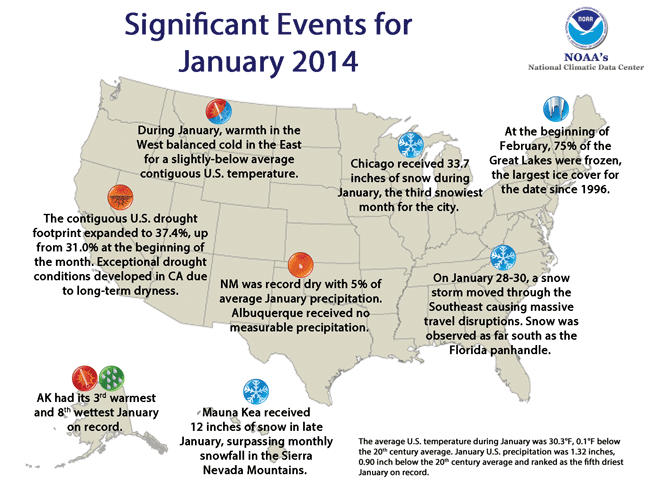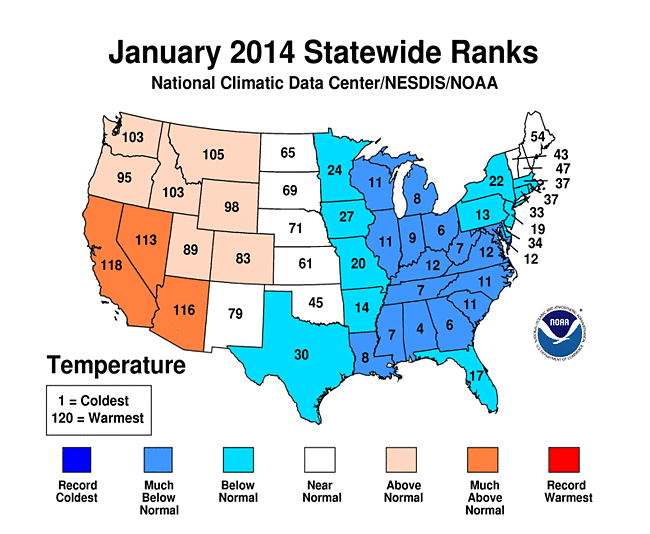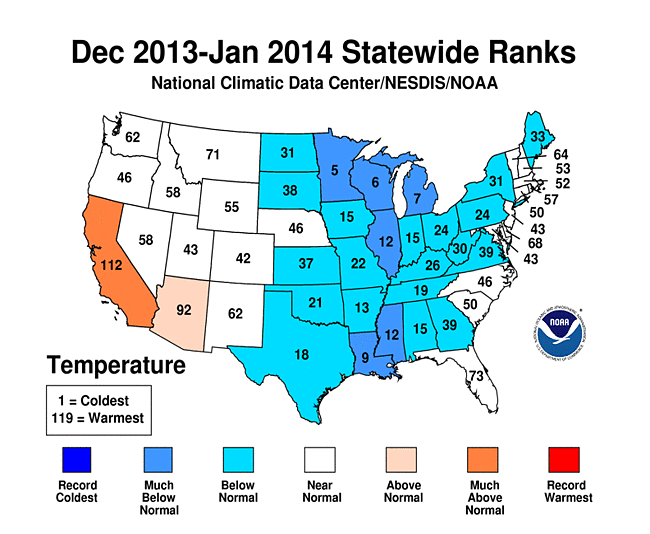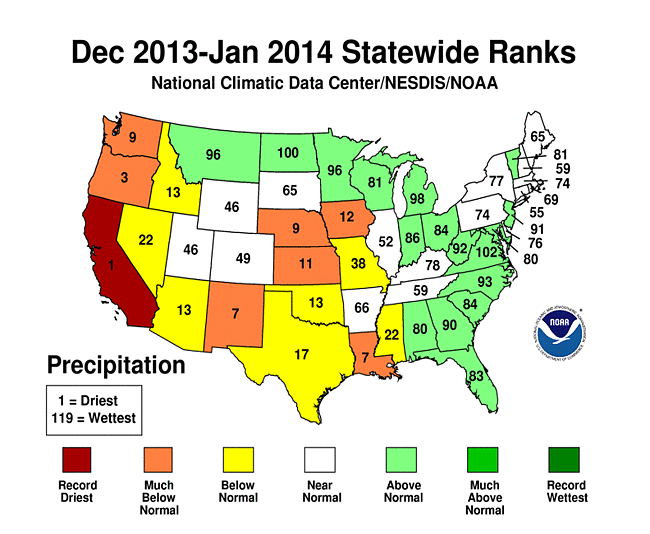Monthly Report Summary Information
The Monthly Report Summary Information is a synopsis of the collection of national and global summaries released each month.
National Summary Information - January 2014
See Full Report
Warm West counterbalances cold East for the contiguous U.S. in January; overall monthly temperature slightly below average
Contiguous U.S. had the fifth driest January on record; Alaska had its third warmest and eighth wettest January
The average temperature for the contiguous United States during January was 30.3°F, or 0.1°F below the 20th century average. The January 2014 temperature ranked near the middle of the 120-year period of record, and was the coldest January since 2011. Despite some of the coldest Arctic air outbreaks to impact the East in several years, no state had their coldest January on record.
The average January national precipitation total was 1.32 inches, 0.90 inch below the 20th century average, ranking as the fifth-driest January on record and the driest since 2003. Dry conditions dominated much of the western and southern United States, with severe-to- exceptional drought engulfing much of California and Nevada. Numerous winter storms impacted the central and eastern U.S., bringing above-average snowfall but closer-to-average total precipitation.

Significant climate events for January 2014. Click image to enlarge, or click here for the National Overview.
Note: The January Monthly Climate Report for the United States has several pages of supplemental information and data regarding some of the exceptional events from the month and season.
U.S. climate highlights: January
- West Virginia had a top 10 cold January.
- Above-average temperatures were observed from the Rockies, westward. Arizona, California, and Nevada each had January temperatures ranking among the 10 warmest on record. No state had an average monthly temperature that was record warm.
- New Mexico had its driest January on record with 0.03 inch of precipitation, 0.57 inch below the 20th century average.
- The Alaska statewide average temperature was 14.8°F above the 1971-2000 average, marking the third-warmest January in the 96-year period of record. This was the warmest January for the state since 1985. Alaska
- According to analysis by the Rutgers Global Snow Lab using NOAA data, the January snow cover extent across the contiguous U.S. was the 16th smallest in the 48-year period of record at 1.28 million square miles, about 82,000 square miles below the 1981-2010 average. Above-average snow cover was observed across the Northern Plains, Midwest, and Northeast where numerous winter storms brought heavy snowfall during the month, while below-average snow cover was observed for most of the West and Southern Rockies.
- According to the February 4 U.S. Drought Monitor report, 37.4 percent of the contiguous U.S. was in drought, up from 31.0 percent at the beginning of January. Drought conditions improved in the Northeast but worsened across the western Gulf Coast, the Southern Rockies, and much of the West. For the first time in the 15-year period of record for the U.S. Drought Monitor, California experienced the worst classification of drought, known as D4 or "exceptional".
U.S. climate highlights: winter-to-date (December 2013–January 2014
- For the first two months of the winter season, the contiguous U.S. average temperature was 30.6°F, 1.1°F below the 20th century average, and the 33rd coldest December-January on record. This was the coldest December-January since 2010/11.
- Below-average temperatures were present for much of the contiguous U.S. east of the Rockies. Louisiana, Michigan, Minnesota, and Wisconsin each had a two-month average temperature that ranked among the 10 coldest. Temperatures in the West were near to above average, where California had its eighth warmest two-month period. No state was record warm or record cold.
- The December-January precipitation total of 3.48 inches for the Lower-48 was 0.97 inch below average and the 11th driest December-January on record and the driest since 2000/01. Above-average precipitation was observed across the Northern Plains, Midwest, and along most of the East Coast. Below-average precipitation was observed across the West, the Central and Southern Plains, and the western Gulf Coast. Six states had two-month precipitation totals ranking among the 10 driest.
- California had its driest December-January on record with 0.94 inch of precipitation, 7.35 inches below average. The previous record dry December-January occurred in 1975/76, when the two-month precipitation total was 1.32 inches. The December-February period is typically the wettest three months for California and is an important time for the state's water resources. Winter precipitation is vital to replenish reservoirs and builds mountain snowpack that melts during the spring and summer. As of February 1, most mountain locations in California had less than 50 percent of normal snowpack and reservoirs across northern and central regions of the state had storage levels between 37 percent and 75 percent of historical averages for the date.
 NOAA's National Centers for Environmental Information
NOAA's National Centers for Environmental Information



